Study on the Effect of Pile Foundation Reinforcement of Embankment on Slope of Soft Soil
Abstract
:1. Introduction
2. Establishment of Numerical Model of Embankment on Slope of Soft Soil
3. Analysis of Influencing Factors
3.1. Strength Reduction Method
3.2. Influence of Pile Foundation Reinforcement Position
3.3. Influence of Pile Foundation Length
4. Conclusions
Author Contributions
Funding
Institutional Review Board Statement
Informed Consent Statement
Data Availability Statement
Conflicts of Interest
References
- Bai, C.-E.; Qian, Y. Infrastructure development in China: The cases of electricity, highways, and railways. J. Comp. Econ. 2010, 38, 34–51. [Google Scholar] [CrossRef]
- Gao, X.; Wang, B.; Sun, D. Do railways improve territorial cohesion of the Tibetan Plateau? A case study of the Qinghai-Tibet Railway. Appl. Geogr. 2022, 144, 102720. [Google Scholar] [CrossRef]
- Feng, S.; Lei, H. A settlement prediction model considering tidal loading and traffic loading of soft soil subgrade. Comput. Geotech. 2022, 144, 104639. [Google Scholar] [CrossRef]
- Zhang, F.; Yashima, A.; Osaki, H.; Adachi, T.; Oka, F. Numerical Simulation of Progressive Failure in Cut Slope of Soft Rock Using a Soil-Water Coupled Finite Element Analysis. Soils Found. 2003, 43, 119–131. [Google Scholar] [CrossRef] [Green Version]
- Wang, Y.; Fu, H.; Cai, Y.; Yu, X.; Zhao, J. Seismic Subsidence of Soft Subgrade with Considering Principal Stress Rotation. Int. J. Civ. Eng. 2022, 20, 827–837. [Google Scholar] [CrossRef]
- Nian, T.-K.; Guo, X.-S.; Zheng, D.-F.; Xiu, Z.-X.; Jiang, Z.-B. Susceptibility assessment of regional submarine landslides triggered by seismic actions. Appl. Ocean Res. 2019, 93, 101964. [Google Scholar] [CrossRef]
- Zang, M.; Yang, G.; Dong, J.; Qi, S.; He, J.; Liang, N. Experimental study on seismic response and progressive failure characteristics of bedding rock slopes. J. Rock Mech. Geotech. Eng. 2022, 14, 1394–1405. [Google Scholar] [CrossRef]
- Yuan, H.; Yu, X.; Zou, D.; Wang, Y.; Li, M.; Liu, J. Time History Method of Three-Dimensional Dynamic Stability Analysis for High Earth-Rockfill Dam and Its Application. Sustainability 2022, 14, 6671. [Google Scholar] [CrossRef]
- Ma, L.; Wang, Y.; Wang, W.; Xu, X.; Li, S. An Analysis Method for near Shore Laterally Loaded Rigid Pile in Cohesive Soil. Mar. Georesour. Geotec. 2016, 36, 2–9. [Google Scholar] [CrossRef]
- Dong, X.; Li, Z.; Cui, Z.; Zhou, C. Stability analysis of the pile-prestressed anchor composite structure based on failure mode. Eng. Fail. Anal. 2022, 137, 106223. [Google Scholar] [CrossRef]
- Hemel, M.-J.; Korff, M.; Peters, D.J. Analytical model for laterally loaded pile groups in layered sloping soil. Mar. Struct. 2022, 84, 103229. [Google Scholar] [CrossRef]
- Huang, Y.; Xu, X.; Liu, J.; Mao, W. Centrifuge modeling of seismic response and failure mode of a slope reinforced by a pile-anchor structure. Soil Dyn. Earthq. Eng. 2020, 131, 106037. [Google Scholar] [CrossRef]
- Wang, Y.; Fu, H.; Wan, Y.; Yu, X. Reliability and parameter sensitivity analysis on geosynthetic-reinforced slope with considering spatially variability of soil properties. Constr. Build. Mater. 2022, 350, 128806. [Google Scholar] [CrossRef]
- Ye, X.; Wu, J.; Li, G. Time-dependent field performance of PHC pile-cap-beam-supported embankment over soft marine clay. Transp. Geotech. 2020, 26, 100435. [Google Scholar] [CrossRef]
- Merifield, R.S.; Goodall, S.J.; McFarlane, S.A. Finite element modelling to predict the settlement of pile groups founded above compressible layers. Comput. Geotech. 2021, 134, 104139. [Google Scholar] [CrossRef]
- Xu, X.; Huang, Y. Parametric study of structural parameters affecting seismic stability in slopes reinforced by pile-anchor structures. Soil Dyn. Earthq. Eng. 2021, 147, 106789. [Google Scholar] [CrossRef]
- Zhang, G.; Wang, L.; Wang, Y. Pile reinforcement mechanism of soil slopes. Acta Geotech. 2017, 12, 1035–1046. [Google Scholar] [CrossRef]
- Wang, Y.; Han, M. Optimal design of slope reinforcement by a new developed polymer micro anti-slide pile in case of emergency and disaster relief. Nat. Hazards 2022, 112, 899–917. [Google Scholar] [CrossRef]
- Wang, Z.; Zhou, H.; Franza, A.; Liu, H. Numerical evaluation of scour effects on lateral behavior of pile groups in clay. Comput. Geotech. 2022, 150, 104913. [Google Scholar] [CrossRef]
- Tang, X.; Yang, M. Analysis of laterally-loaded piles in weathered rock slopes based on p-y curve method. Int. J. Geotech. Eng. 2018, 14, 809–819. [Google Scholar] [CrossRef]
- Chandaluri, V.K.; Sawant, V.A. Influence of sloping ground on lateral load capacity of single piles in clayey soil. Int. J. Geotech. Eng. 2018, 14, 353–360. [Google Scholar] [CrossRef]
- Li, X.; Pei, X.; Gutierrez, M.; He, S. Optimal location of piles in slope stabilization by limit analysis. Acta Geotech. 2012, 7, 253–259. [Google Scholar] [CrossRef]
- Khati, B.S.; Sawant, V.A. Comparison of lateral response of pile group in series and parallel arrangement near sloping ground. Int. J. Geotech. Eng. 2019, 14, 686–695. [Google Scholar] [CrossRef]
- Peng, W.; Zhao, M.; Zhao, H.; Yang, C. A two-pile foundation model in sloping ground by finite beam element method. Comput. Geotech. 2020, 122, 103503. [Google Scholar] [CrossRef]
- Tran, N.X.; Gu, K.-Y.; Yoo, M.; Kim, S.-R. Numerical evaluation of slope effect on soil–pile interaction in seismic analysis. Appl. Ocean Res. 2022, 126, 103291. [Google Scholar] [CrossRef]
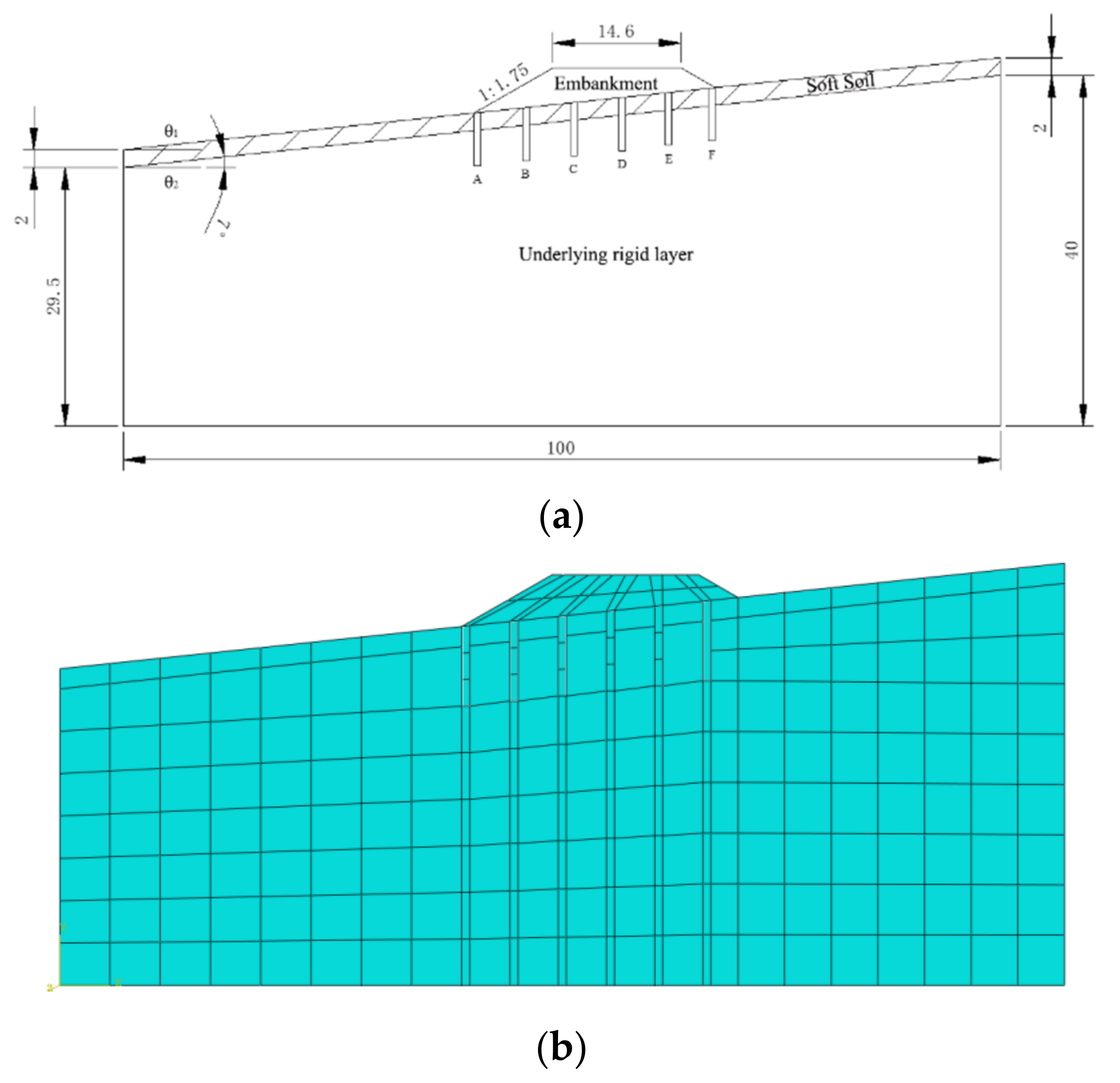
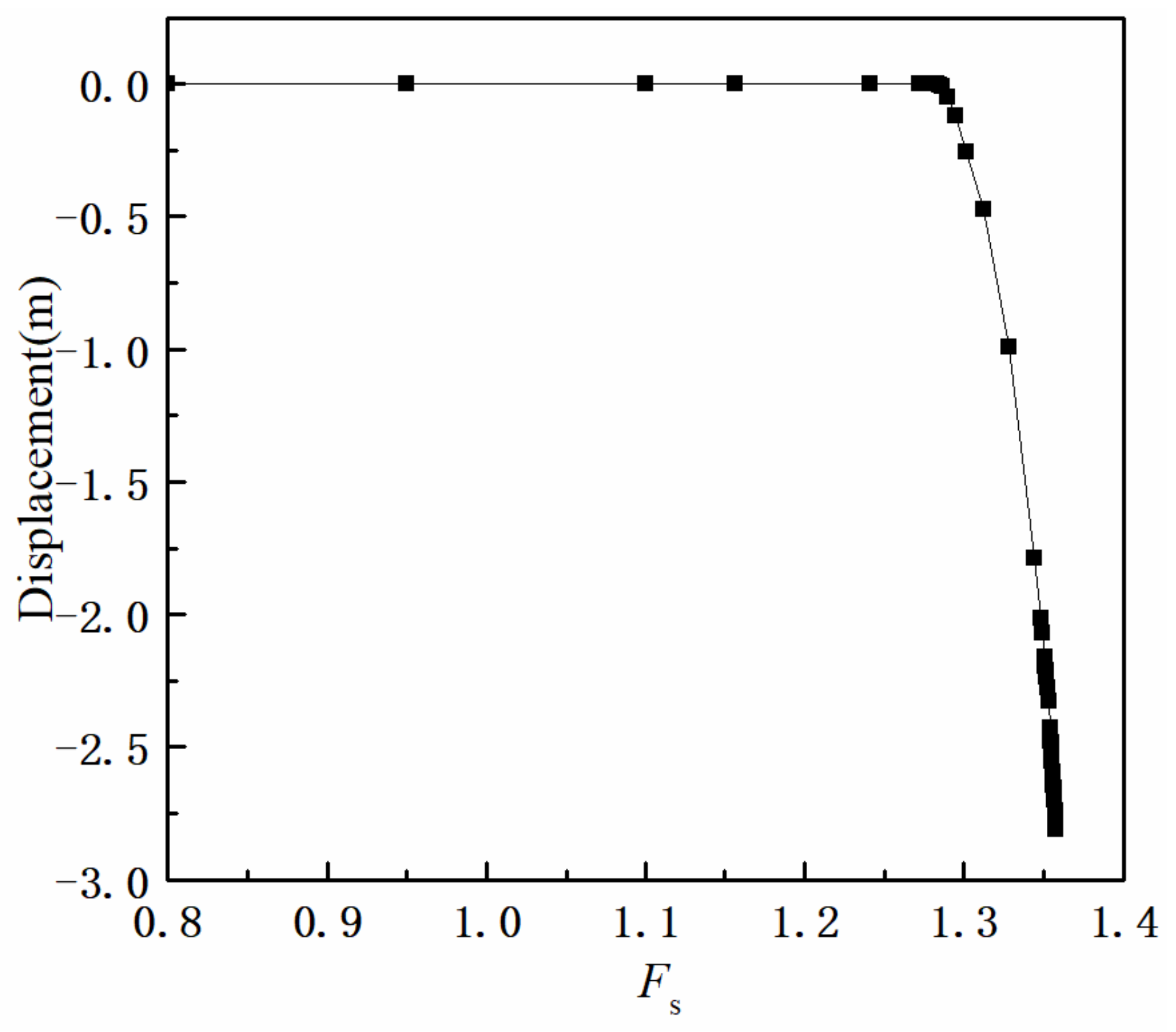
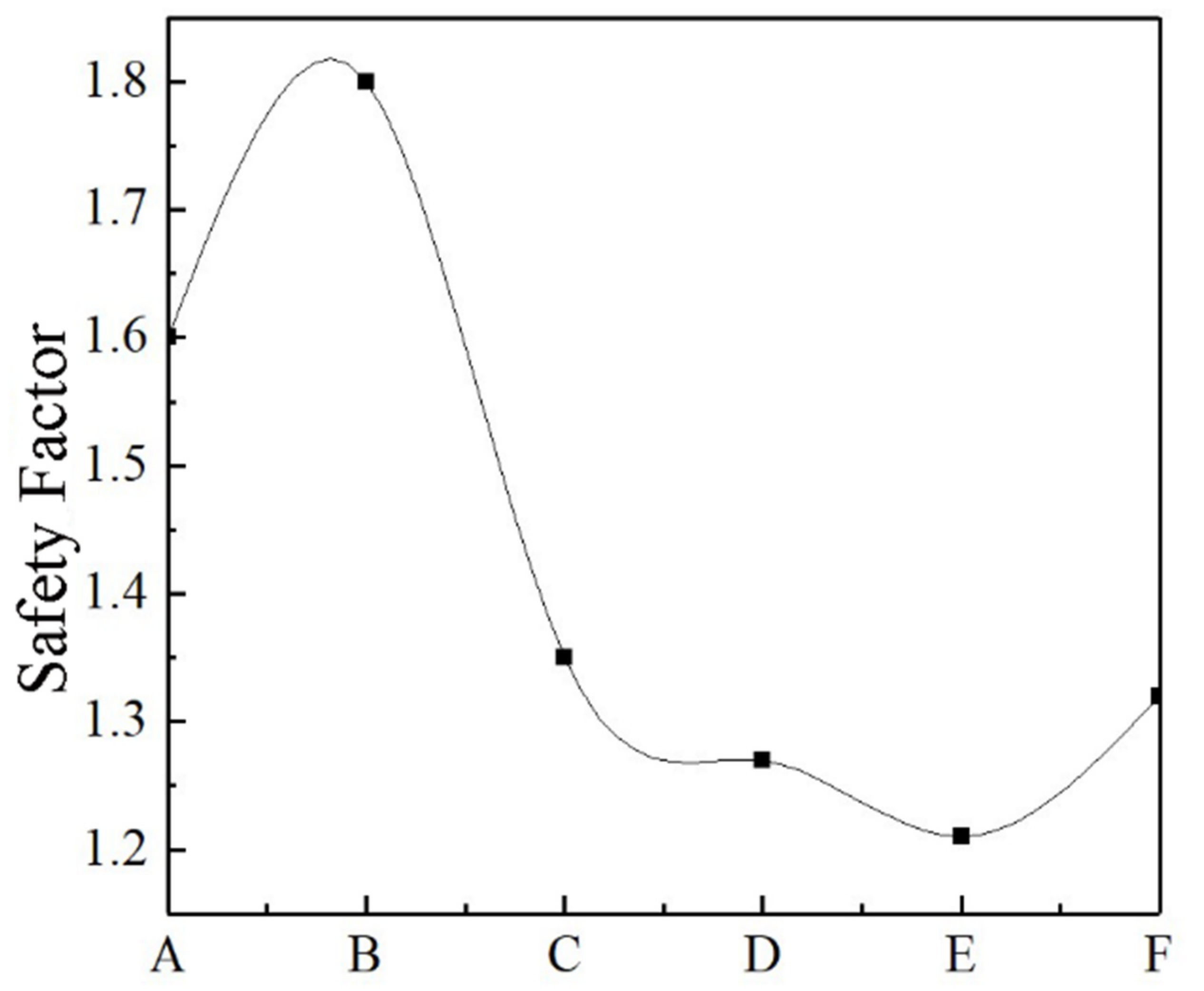

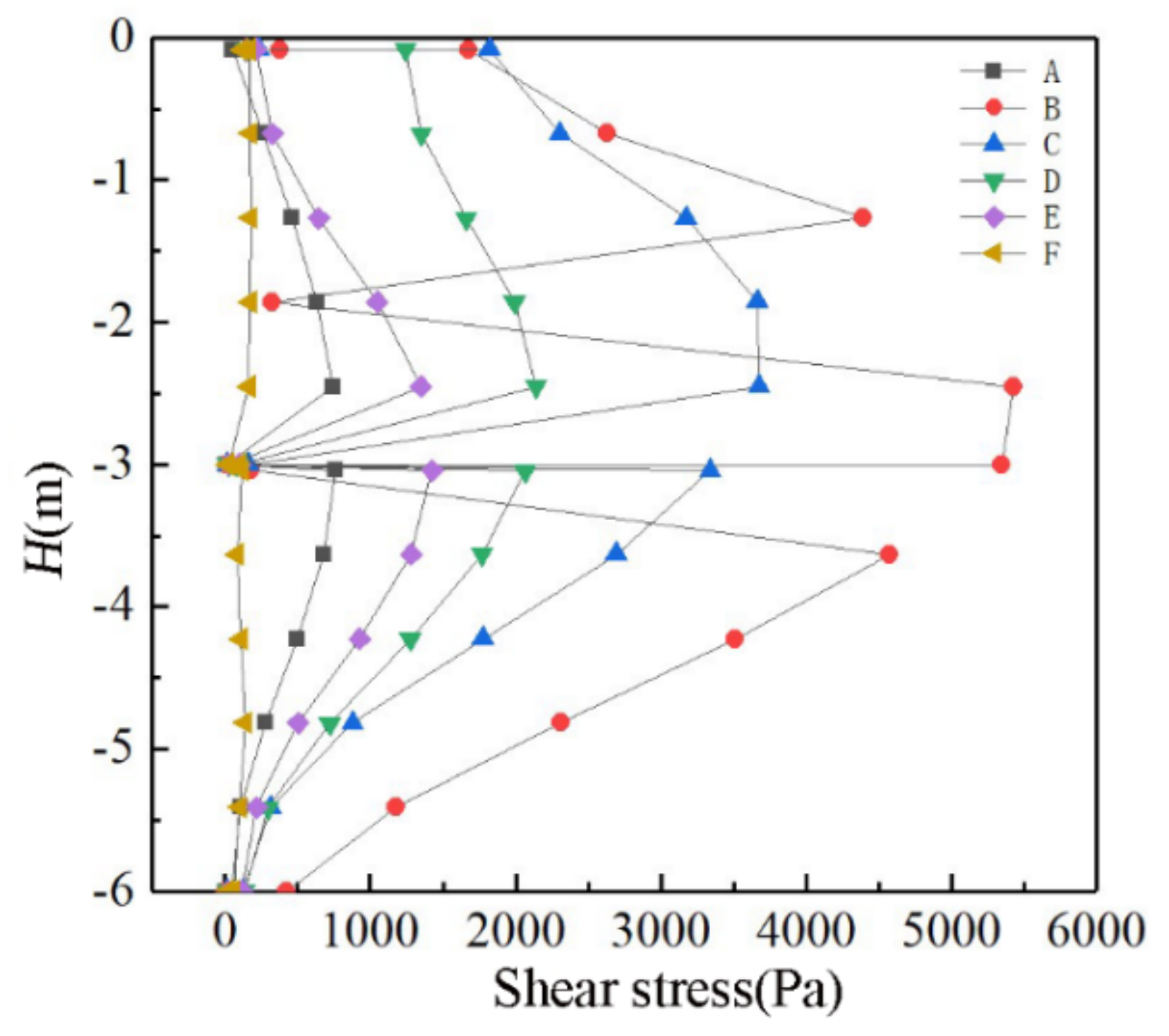
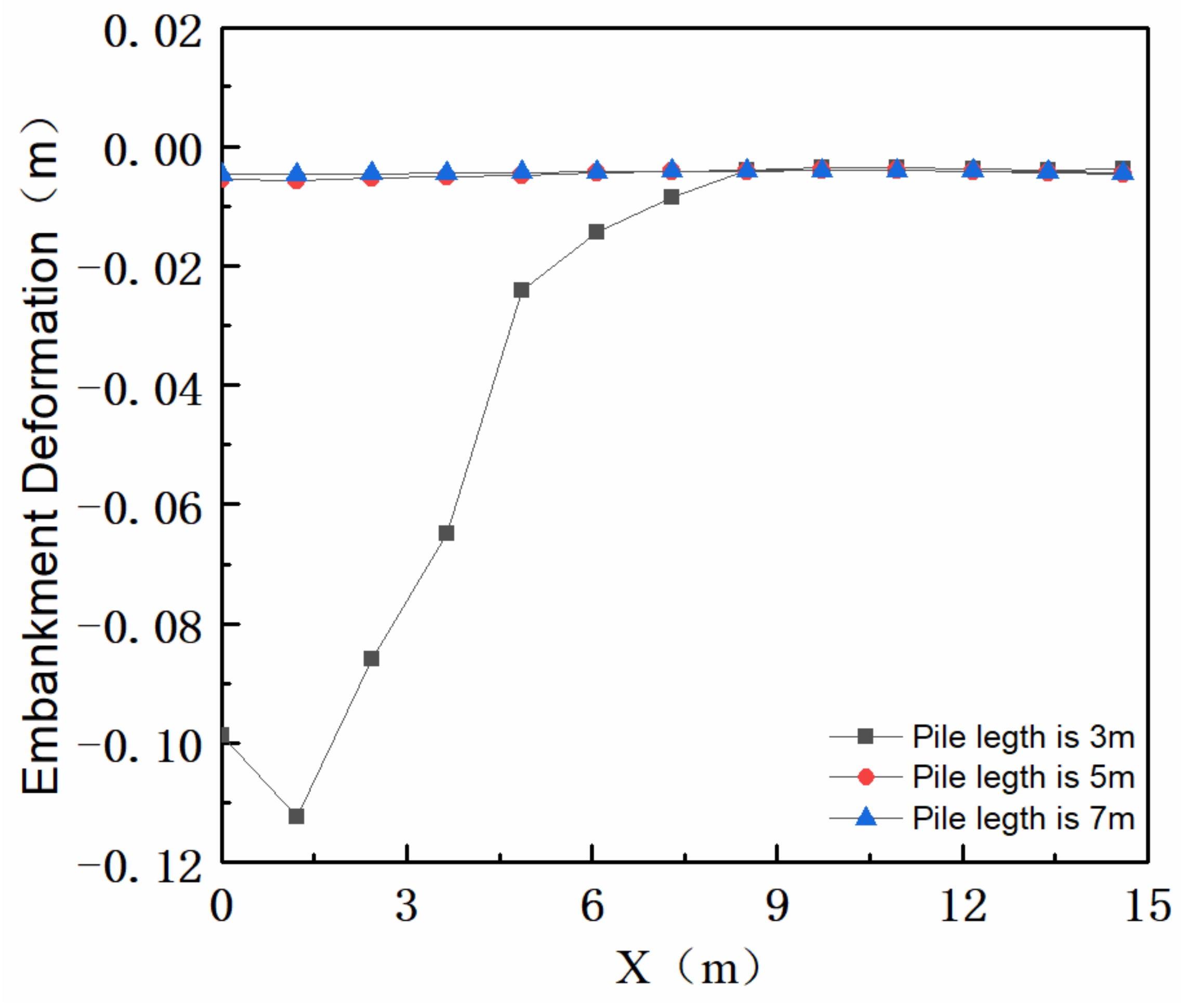
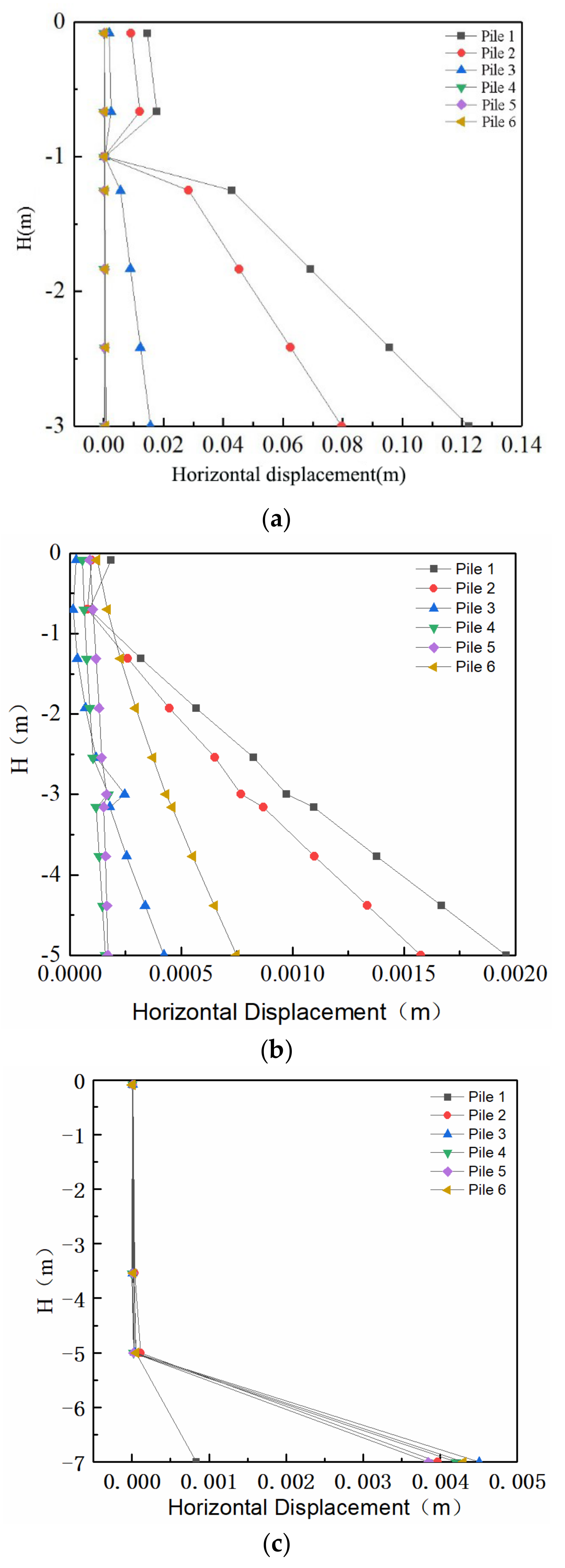
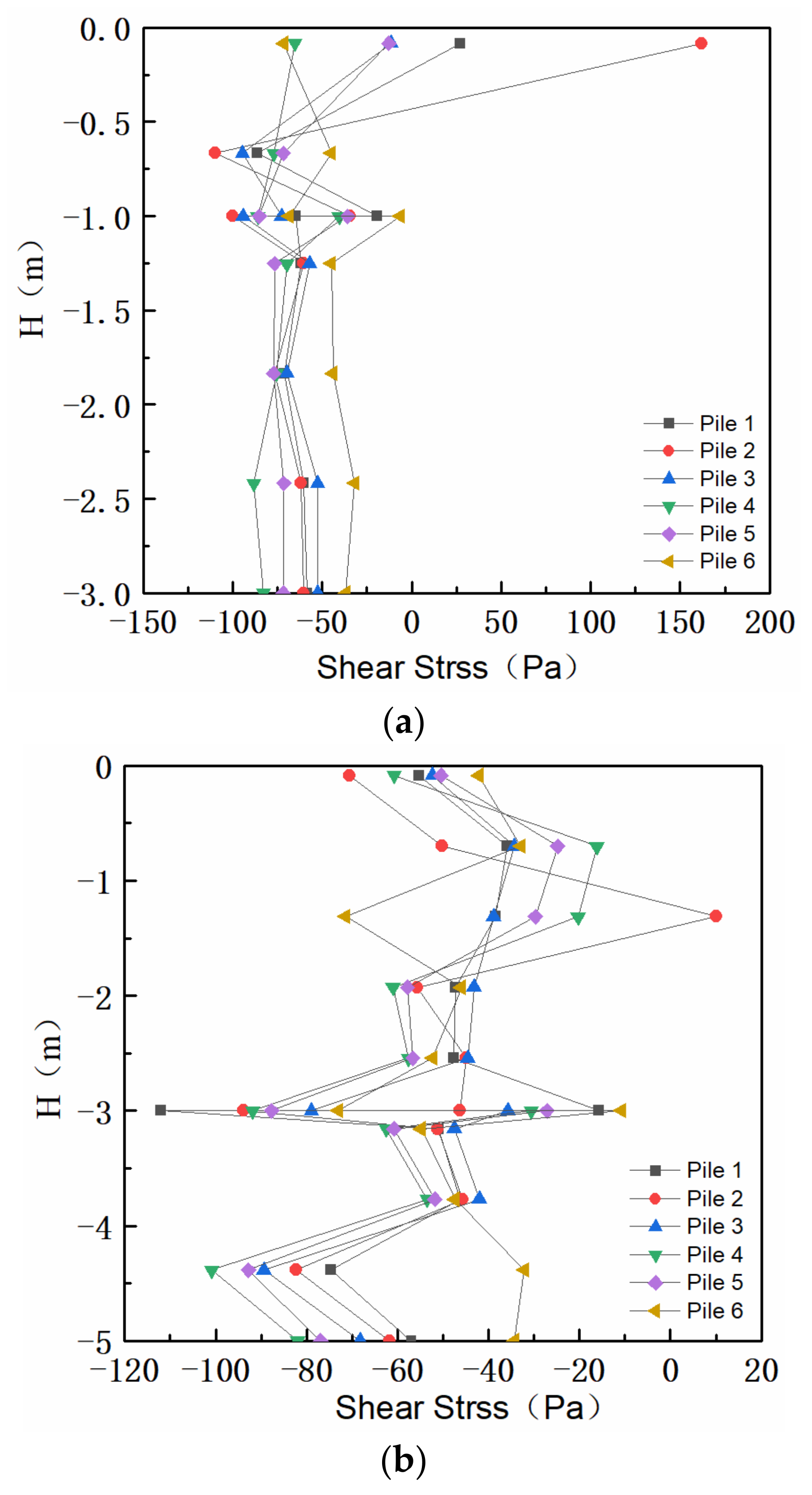

| Project | Elastic Modulus (MPa) | Poisson’s Ratio | γ (kN/m3) | Cohesion (kPa) | Internal Friction Angle (°) |
|---|---|---|---|---|---|
| Embankment fill | 100 | 0.35 | 19 | 20 | 25 |
| Soft soil | 10 | 0.35 | 18 | 10 | 0 |
| Underlying rigid layer | 250 | 0.25 | 23 | \ | \ |
| Pile foundation | 30,000 | 0.2 | \ | \ | \ |
| Pile Length/m | Pile Diameter/m | Pile Spacing/m | Safety Factor |
|---|---|---|---|
| 3 | 0.8 | 4 | 4 |
| 5 | 0.8 | 4 | 4 |
| 7 | 0.8 | 4 | 4 |
Publisher’s Note: MDPI stays neutral with regard to jurisdictional claims in published maps and institutional affiliations. |
© 2022 by the authors. Licensee MDPI, Basel, Switzerland. This article is an open access article distributed under the terms and conditions of the Creative Commons Attribution (CC BY) license (https://creativecommons.org/licenses/by/4.0/).
Share and Cite
Wang, F.; Shao, J.; Li, W.; Wang, Y.; Wang, L.; Liu, H. Study on the Effect of Pile Foundation Reinforcement of Embankment on Slope of Soft Soil. Sustainability 2022, 14, 14359. https://doi.org/10.3390/su142114359
Wang F, Shao J, Li W, Wang Y, Wang L, Liu H. Study on the Effect of Pile Foundation Reinforcement of Embankment on Slope of Soft Soil. Sustainability. 2022; 14(21):14359. https://doi.org/10.3390/su142114359
Chicago/Turabian StyleWang, Feifei, Jinggan Shao, Wenkai Li, Yafei Wang, Longfei Wang, and Honglin Liu. 2022. "Study on the Effect of Pile Foundation Reinforcement of Embankment on Slope of Soft Soil" Sustainability 14, no. 21: 14359. https://doi.org/10.3390/su142114359
APA StyleWang, F., Shao, J., Li, W., Wang, Y., Wang, L., & Liu, H. (2022). Study on the Effect of Pile Foundation Reinforcement of Embankment on Slope of Soft Soil. Sustainability, 14(21), 14359. https://doi.org/10.3390/su142114359








